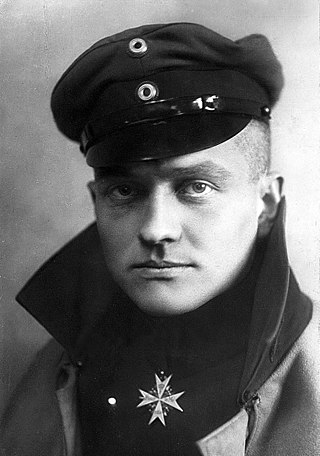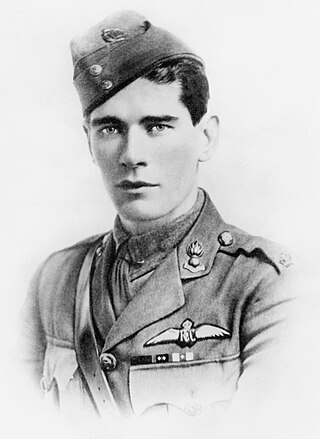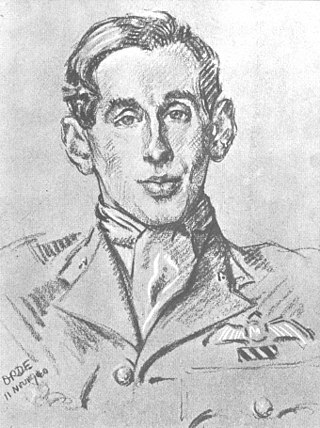Related Research Articles

Manfred Albrecht Freiherr von Richthofen, known in English as Baron von Richthofen or the Red Baron, was a fighter pilot with the German Air Force during World War I. He is considered the ace-of-aces of the war, being officially credited with 80 air combat victories.

The Fokker Scourge occurred during the First World War from July 1915 to early 1916. Imperial German Flying Corps units, equipped with Fokker Eindecker fighters, gained an advantage over the Royal Flying Corps (RFC) and the French Aéronautique Militaire.

A flying ace, fighter ace or air ace is a military aviator credited with shooting down five or more enemy aircraft during aerial combat. The exact number of aerial victories required to officially qualify as an ace is varied, but is usually considered to be five or more.
This is a list of aviation-related events from 1918:

Edward Corringham "Mick" Mannock was a British and Irish flying ace who served in the Royal Flying Corps and Royal Air Force during the First World War. Mannock was a pioneer of fighter aircraft tactics in aerial warfare. At the time of his death he had amassed 61 aerial victories, making him the fifth highest scoring pilot of the war. Mannock was among the most decorated men in the British Armed Forces. He was honoured with the Military Cross twice, was one of the rare three-time recipients of the Distinguished Service Order, and was posthumously awarded the Victoria Cross.

Air Commodore Arthur Henry Cobby, was an Australian military aviator. He was the leading fighter ace of the Australian Flying Corps (AFC) during World War I, despite seeing active service for less than a year.

Air Commodore Keith Logan "Grid" Caldwell, was a New Zealand fighter ace of the Royal Flying Corps in the First World War who also rose to the rank of air commodore in the Royal New Zealand Air Force during the Second World War.

No. 40 Squadron of the Royal Air Force was formed in 1916 at Gosport as No. 40 Squadron Royal Flying Corps and was disbanded for the last time in 1957. The squadron also included many non-British members, including volunteers from the Royal Australian Air Force and Royal Canadian Air Force.

Air Marshal Sir George Jones, was a senior commander in the Royal Australian Air Force (RAAF). He rose from private soldier in World War I to air marshal in 1948, and served as Chief of the Air Staff from 1942 to 1952, the longest continuous tenure of any RAAF chief. Jones was a surprise appointee to the Air Force's top role, and his achievements in the position were coloured by a divisive relationship during World War II with his nominal subordinate, the head of RAAF Command, Air Vice-Marshal William Bostock.
For the British diplomat, see Augustus Paget.
Lieutenant James McDonald was a British World War I flying ace credited with eight aerial victories.

Air Commodore Ronald Burns Bannerman was a flying ace during World War I, as well as serving as a high level administrator for his native New Zealand's air force during World War II.
Captain George Everard Gibbons was a British World War I flying ace credited with 18 aerial victories gained while flying a Bristol F.2 Fighter in 1918. Both of his observers, Sidney Knights and Thomas Elliott, also became aces flying with him. Gibbons' final tally consisted of three enemy aircraft destroyed by fire, five others destroyed, and ten driven down out of control.
Flight Lieutenant Frank George Gibbons was a British First World War flying ace credited with fourteen aerial victories. He served in the Royal Air Force post-war, until killed in a flying accident during an air race.
Second Lieutenant John Howard Umney was an English flying ace from World War I. He flew as a gunner/observer in the rear seat of Bristol F.2B Fighters, and was credited with 13 official aerial victories.
Captain George Henry Hackwill was an English World War I flying ace credited with nine aerial victories. His most notable victory was his role in shooting down a German Gotha G.V, over Essex on the night of 28 January 1918. This was the first victory ever achieved in combat between aircraft at night.
Captain Norman Cyril Jones was an English flying ace during World War I. He was credited with nine aerial victories.

John Charles Dundas, was a Royal Air Force fighter pilot and flying ace of the Second World War credited with 12 victories.
Lieutenant Valentine St. Barbe Collins was a World War I British flying ace credited with ten aerial victories who served with the Royal Flying Corps and the Royal Air Force.
References
- 1 2 "John Jones". The Aerodrome. 2015. Retrieved 15 April 2015.